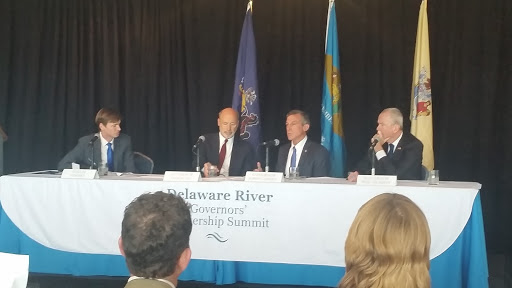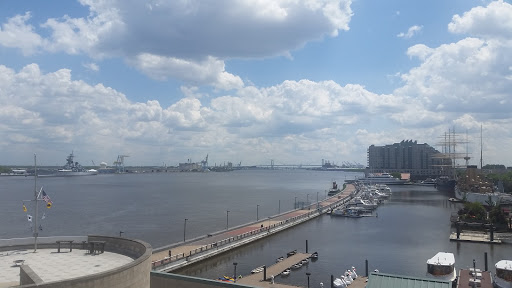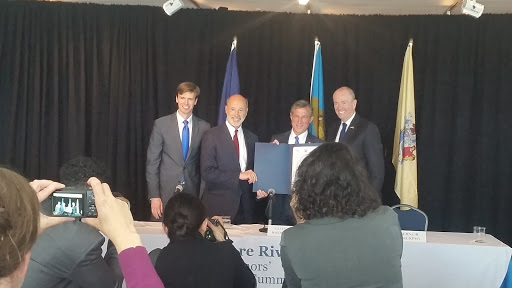
By Rachel Rosenfeld, Sierra Club PA Community Outreach Coordinator
Philadelphia, PA -- May 16, 2019 marked a historic moment for the future of the Delaware River. For the first time since the signing of the Delaware River Basin Commission Compact in 1961, the Governors of Pennsylvania, New Jersey, and Delaware came together for the Delaware River Governors’ Leadership Summit in Philadelphia to make a shared pledge to protect and restore the Delaware River Watershed and call on the federal government for support.
The Governors were joined by a number of state government agencies, members of the press, foundations, and conservation nonprofit partners at the Independence Seaport Museum. Organizations in attendance applauded them for signing a proclamation re-affirming their commitment to a watershed-wide vision to make the Delaware River Basin a national model for sustainable economic development, drinkable clean water, healthy fish and wildlife populations, outdoor recreation, and nature-based climate resilience.
“Nothing brings us together like the Delaware River,” stated Governor Tom Wolf. “This is a big deal!”
During a forum moderated by Collin O’Mara, President and CEO of the National Wildlife Federation, while looking out at the calm, reflective blue waters of the Delaware River, Governor Tom Wolf of PA, Governor Phil Murphy of NJ, and Governor John Carney of DE, discussed questions about the opportunities and challenges facing this “founding waterway”, which supplies drinking water to over 13.3 million people.

View from the Independence Seaport Museum of the Delaware River and waterfront pier.
When asked how they foresee communities within the 13,539 square mile basin becoming more adaptive and resilient in the face of escalating climate impacts, Governor Murphy responded, “Governors have never mattered more!” He discussed that it has been 6.5 years since the devastating hurricane Sandy hit New Jersey’s coastline, and millions of New Jersey residents are still not back in their homes. “The difference between where the water table is now, and where it could be, is very fragile.”
Governor Wolf chimed in that Pennsylvania has also suffered a lot of damage due to relentless ongoing flooding. He made a pitch for his new infrastructure plan, Restore PA, which includes funding for priorities like disaster recovery, critical flood control, green stormwater infrastructure, and contaminant remediation. Having recently joined the U.S. Climate Alliance, he said, “Pennsylvania is [currently] in a position to do something.”
As these three states each have a unique relationship with the river, Mr. O’Mara posed another question about the significance of this shared natural resource and regional economic driver. Governor Murphy quickly shared that for New Jersey, a “water rich” state, the Delaware River is a crown jewel and “... the backbone of economic development, recreation, and the source of approximately 25 percent of our clean drinking water.”
Growing up in Claymont, Delaware, Governor Carney remarked he was not able to access the river due to industry. “One of the privileges of being an elected official is experiencing the great places around the state,'' he said referencing the uniqueness of the Delaware Bayshore. A world-class destination for outdoor recreation and birdwatching, the Delaware Bay has the world’s largest population of horseshoe crabs and the second-highest concentration of shorebirds in North America.
In Pennsylvania, 17 counties lie entirely or partly within the watershed. “The Delaware River is a great resource for recreation, an economic engine for the eastern part of our state, and a vital drinking water source for millions of Pennsylvanians,” said Governor Wolf. “We’re proud of the work we’ve done to clean up our waterways and look forward to working with our neighboring states to continue our progress.”
While the country has come a long way since the Clean Water Act was amended in 1972, we still have a way to go towards achieving the national vision for drinkable, fishable, and swimmable waters. Most recently, in the absence of federal support under the Trump administration, collaborative, cross-state solutions are playing an increasingly crucial role to ensuring protections for clean water.
In describing their visions for the Delaware River, the Governors pointed to the strength of their combined regional efforts. Governor Carney suggested that by “working together, we will aim to get other lawmakers to support the Delaware River Watershed” for current and future generations. Governor Murphy agreed and showed pride in supporting Governors Carney and Wolf, saying that “coming together, we exemplify what any one of us could do individually.”

The summit concluded with an eruption of cheers and camera flashes as the Governors’ signed the proclamation. Attendees commended the Governors’ action, which signifies a sincere commitment to maintaining their pledge to advance a healthy Delaware River Watershed for residents, wildlife and the $22 billion regional economy, which supports about 600,000 jobs.
Let us recognize the importance of this momentous event and look forward with confidence towards meeting the goal of drinkable, fishable, and swimmable waters -- together!
(All photos were taken by Rachel Rosenfeld)